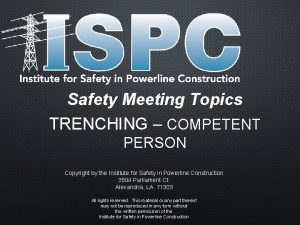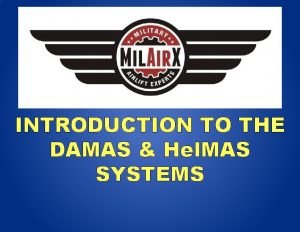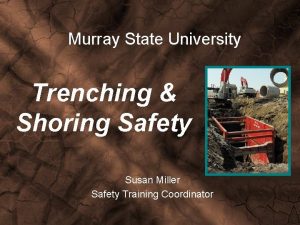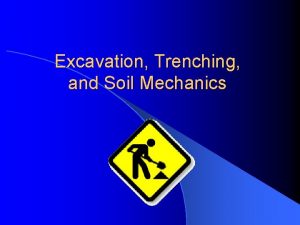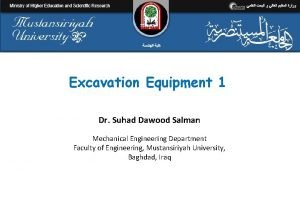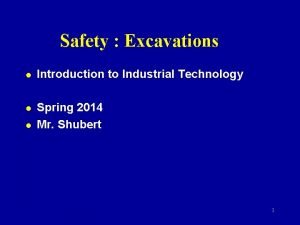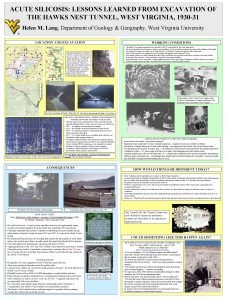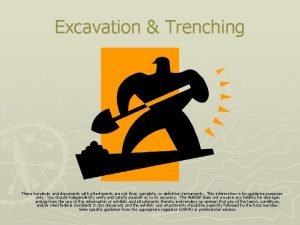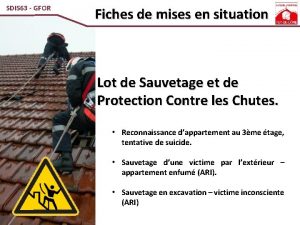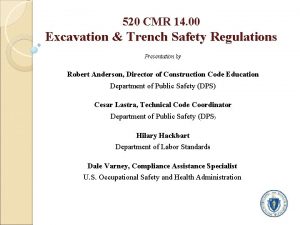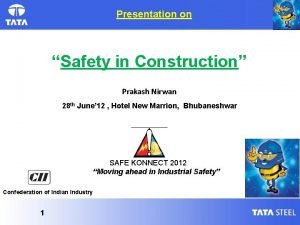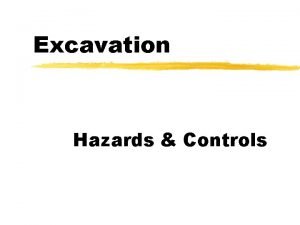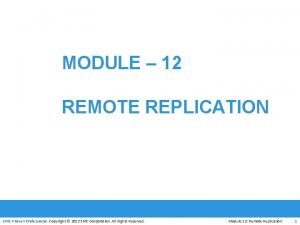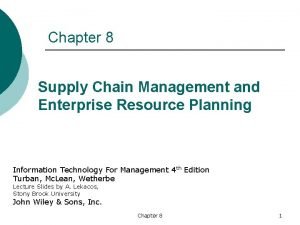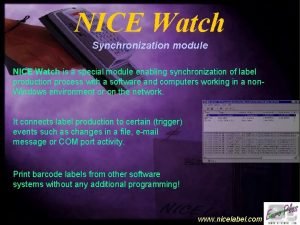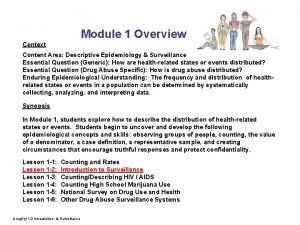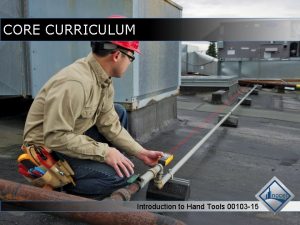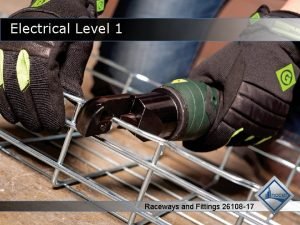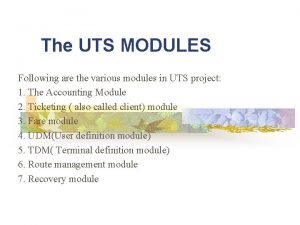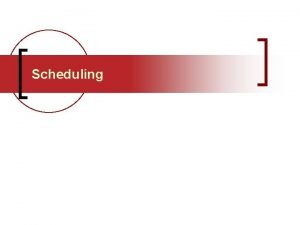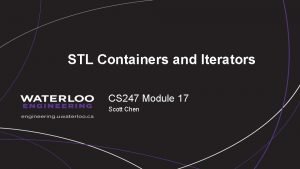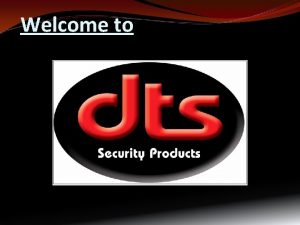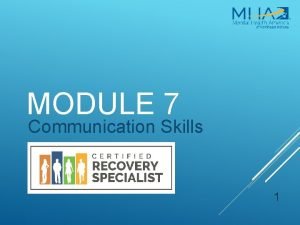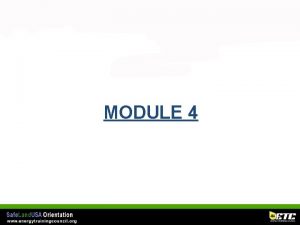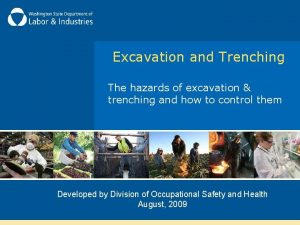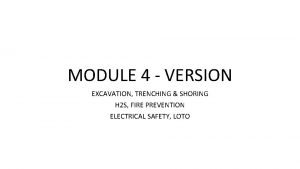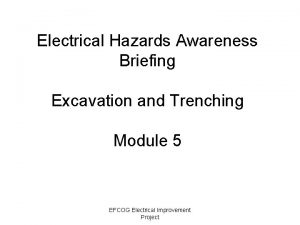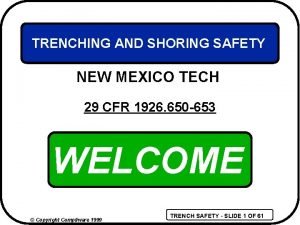MODULE 4 Excavation Trenching Shoring Excavation Trenching Shoring







































































- Slides: 71

MODULE 4

Excavation (Trenching & Shoring)

Excavation – Trenching & Shoring • Excavating is one of the most hazardous forms of construction activity due to the possibility of cave-ins. • Excavating emergencies are more likely to result in a serious injury or fatality than any other construction accident. • Trench accidents result in approximately 100 fatalities per year.

Excavation – Trenching & Shoring By Law all underground hazards shall be identified before work begins. Utilize ONE CALL – 811

Excavation – Trenching & Shoring APWA Color Codes • Proposed Excavation • Temporary Survey • Electrical • Gas • Communications • Potable Water • Irrigation • Sewer

Excavation – Trenching & Shoring • Site workers are those employees working on a site or location that has an excavation project. • Excavation Workers are those employees working on the excavation project • Site workers are not authorized to work on the excavation project.

Excavation – Trenching & Shoring • A competent person is defined as one who is capable of identifying existing and predictable hazards in the surroundings, or working conditions which are unsanitary, hazardous, or dangerous to employees and who has the authority to take prompt corrective measures to eliminate them

Excavation – Trenching & Shoring • Inspections – Inspections must be performed by the competent person • • • Prior to start of work As needed throughout shift Daily After rainstorms Other hazard changes Exposure reasonably expected

Excavation – Trenching & Shoring • Work Practices – Methods to prevent cave-ins • Shielding and shoring • Relies on mechanical structures – Sloping and benching • Based on soil type

Excavation – Trenching & Shoring • Work Practices – Good work practices shall include proper training of all employees on dangers associated with trenching and shoring. – No employee shall be allowed on or around an excavation without proper personal protective equipment including atmospheric monitoring devices.

Excavation – Trenching & Shoring • No employee shall be allowed on or around an excavation that does not have a protective system in place, if necessary. • Atmospheric testing shall be done before entering the trench. Additional monitoring shall be done as per company requirements. • Means of exit must be within 25 feet of lateral travel if greater than four feet in depth.

Excavation – Trenching & Shoring • Employees shall not work in excavations where there is an accumulation of water unless precautions have been taken to protect employees. – Precautions should include but are not limited to: • Special support or shield systems • Water removal or control • Safety harness with lifeline

Excavation – Trenching & Shoring • Hazards – Oxygen deficient atmospheres. – Loose rocks or soil. – Overhead loads being carried/lifted by digging equipment.

Excavation – Trenching & Shoring • Personal Protective Equipment (PPE) – Respirators – employees must be fit tested and have proper training before use. • Hazardous Atmospheres – <19. 5% or >23. 5% Oxygen (MN 5207. 300) – Combustible gas >10% LEL (LFL) – Concentrations of toxic materials > TLV established by ACGIH

Excavation – Trenching & Shoring • Some trenches qualify as a confined space. Therefore compliance with the Confined Space regulations would be required. • Atmospheric testing shall be done: – Before employees enter the area – Periodically to ensure the atmosphere is still safe – Periodic testing shall increase if you are operating equipment in the trench.

Excavation – Trenching & Shoring Emergency & Non-Entry Rescue • In the event of an emergency situation requiring rescue, personnel SHALL NOT attempt to enter an unprotected trench to perform rescue. – Call emergency services in your area. – Rescue services that can be performed safely from outside the excavation, such as hoisting a harnessed victim, shall be undertaken.

Excavation – Trenching & Shoring • Other rescue equipment shall include: – Breathing equipment – Basket stretcher – Attendees

Hydrogen Sulfide H 2 S

Hydrogen Sulfide • Hydrogen Sulfide (H 2 S) gas is deadly in relatively low concentrations. • H 2 S gas is created by the decomposition of animal or vegetable matter. • H 2 S gas may be found in oil and gas wells, storage tanks, sewers, mines, gas plants and refineries. • What you don’t know can hurt you!

Hydrogen Sulfide • Hydrogen Sulfide (H 2 S) gas is referred to by many names: – – – Rotten egg gas Stink gas Sour gas Sulfureted Hydrogen gas Sewer gas Devil’s breath

Hydrogen Sulfide • • • Greatest danger is inhalation SPECIFIC TRAINING IS REQUIRED Use of respirator Signs posted Areas monitored

Hydrogen Sulfide • (H 2 S) Properties and Characteristics – – – – Toxic Colorless Offensive odor Soluble Corrosive Heavier than air Flammable Produces toxic bi-products

Hydrogen Sulfide Possible Symptoms of H 2 S Exposure: • • • Eye irritation Fatigue Throat irritation Skin irritation Headache Nausea • Dizziness • Loss of consciousness • Vomiting • Irrational behavior • Coughing • Excitement

Hydrogen Sulfide • Toxicity Levels: – 20 ppm Permissible Exposure Limit (PEL) – 10 ppm Action Level – 100 ppm Immediately Dangerous to Life and Health (IDLH) – 1000 ppm Dead Right There (DRT)

Hydrogen Sulfide • If the event of an H 2 S alert and the monitor alarm sounds, employees are to evacuate quickly moving up wind or cross wind, to high ground. • Check the wind sock or guy wire flags to determine wind direction.

Fire Safety & Emergency Evacuation

Fire Safety – Prevention and Protection • Actions to be taken: – – – Prevent or reduce likelihood of a fire Alert the presence of a fire Enable survival Reduce damage Know the level of training of each employee Respond only to the level of training

Fire Safety – Prevention and Protection • Three Elements of a Fire: – Air – Fuel – Heat • All three elements are needed to begin the chemical chain reaction that is Fire. • When one leg of the fire triangle is removed combustion stops.

Fire Safety – Prevention and Protection • Class A Fires • Class B Fires • Class C Fires • Class D Fires D • Class K Fires K

Fire Safety – Prevention and Protection • Remember the PASS System – Pull – Aim – Squeeze – Sweep

Fire Safety – Prevention and Protection • Pull the Pin – This will allow you to discharge the extinguisher. • Aim – Aim at the base of the fire instead of the flames.

Fire Safety – Prevention and Protection • Squeeze the Handle – This will release the pressurized extinguishing agent. • Sweep – Sweep from side to side until the fire is out.

Fire Safety – Prevention and Protection • HOT WORK – Examples • Welding • Flame Cutting • Grinding Using a torch • Obtain Hot Work permit prior to performing any Hot Work activity

Fire Safety – Prevention and Protection • FIRE WATCH – Duties • Have appropriate fire extinguisher readily available • Ensure conditions of permit are enforced • Remain at hot work area for at least 30 minutes after completion of the hot work • Prior to beginning work, discuss the Emergency Action Plan.

Emergency Evacuation • The immediate and rapid movement of people away from the threat and immediate danger. • Emergency evacuation should be planned prior to any type of emergency that could exist in your field of operation.

Emergency Evacuation • All employees shall be trained and familiar with the emergency evacuation program. • The program shall be displayed in an accessible area for all employees. • Keep all exits clear of obstructions. • Know your assembly point in the event of an evacuation. • Be familiar with the company notification protocol.

Electrical Safety

Electrical Safety • Electricity is a silent and invisible force that can kill without warning if ignored – treat with respect and caution. • Electricity takes multiple paths, flowing through the path of least resistance. • The body can act as an excellent conductor since it is made up of water, chemicals and minerals. • The body can bridge the gap between two voltage levels resulting in an electric shock.

Electrical Safety Electrical Hazards – Sparks from static or equipment • Fires • Explosions – Faults in lines or equipment • Fires • Explosions • Shocks

Electrical Safety • Causes of Electrical Hazards – Hazardous conditions • • • Wet surrounding Outdoor Activities Cramped spaces Explosive atmospheres Arcing Equipment wear and tear

Electrical Safety • Safe Work Practices – – – Lockout/Tagout Proper Authorization Electrical protective equipment Keeping a safe distance from energized circuits Equipment Inspection Using proper tools (GFCI, Insulated tools)

Electrical Safety • Working Near Exposed Parts – Energized Equipment – anything connected or contacted to an electrical source. Has the power on! – De-Energized Equipment – being free from any electrical connection to a source. Has the power disconnected from the source! Example: lockout/tagout

Electrical Safety De-Energized Parts • Treat any conductors and parts of electric equipment as energized that have been de-energized. • Lockout/Tagout should always be used.

Electrical Safety Energized Parts – Only qualified employees: • May work on or with exposed energized lines or parts of equipment. • May work in areas containing unguarded, un-insulated energized lines.

Electrical Safety Overhead Line Safety – Don’t operate equipment around overhead power lines unless you are authorized to do so. – If an object must be moved in the area of overhead power lines, appoint a competent worker as a spotter. – Never touch an overhead line. – Never assume lines are dead.

Electrical Safety – When a machine is in contact with overhead lines, DO NOT allow anyone to come near or touch the machine. – Never touch a person who is in contact with a live power line. – If you are in a vehicle that is in contact with an overhead power line, DO NOT LEAVE THE VEHICLE and do not touch any metal parts within the vehicle. – Avoid storing materials under or near overhead power lines.

Electrical Safety – Portable equipment is not part of a fixed installation but when used is connected to a fixed installation by means of a flexible cable, plug and socket. – – – Never raise or lower by cord Ensure there are grounding prongs No exposed or repaired wiring Approved portable electrical equipment Use a portable GFCI

Electrical Safety • Inspection – Portable Electrical Equipment • • • Ensure ground connection on plug ends Ground prong is not removed Inspect prior to use Avoid long extension cords Use approved couplers Replace damaged extension cords

Electrical Safety • Inspection – Ground Fault Circuit Interrupters • • • Best protection from electrical injury Interrupts circuit Protects people, not equipment Test periodically Installed between extension cord and load

Electrical Safety • Inspection – Welding cable • • • Inspect prior to use No splices within 10 feet of holder Repair or replaced if damaged Connect appropriately Never wrap around body part

Electrical Safety • Avoiding the hazards – Never use broken or faulty equipment – Electrical PPE • Must be inspected • Includes – Gloves – Matting – Blankets - Covers - Line hoses - Sleeves

Electrical Safety • During well servicing operations, grounding is to be provided between the rig and wellhead with a grounding cable securely connected in the casing. • Derrick personnel must vacate the derrick during thunderstorms and all workers are to move away from the derrick.

Lockout/Tagout

Lockout / Tagout • Lockout is the process of blocking the flow of energy (electrical, fluid, air etc. ) from a power source with a blocking device to eliminate the power to disable the equipment. • A lockout device may be a lock, chain, block or special locking device that keeps the power in an “off” position.

Lockout / Tagout • This program does not apply to handheld power tools or stationary equipment whose electrical power may be controlled by the unplugging of equipment from the energy source.

Lockout / Tagout • Types of Energy Sources – Kinetic Energy – the force caused by the motion of an object. – Potential Energy – the force stored in an object that isn’t moving.

Lockout / Tagout Energy sources may include any one or combination of the following: – – – Electrical Mechanical Hydraulic Thermal/steam Gravitational All forms of potential stored energy – Fluid under pressure/oil, water – Gases – Pneumatic – Nuclear – Chemical

Lockout / Tagout • Employees are to be trained in LO/TO procedures. • Training must be done prior to participation in the program, and if a change occurs. – Authorized Employee: person who physically locks and tags equipment for maintenance or servicing. – Affected Employee: person who may operate or work in areas where equipment is subject to the LO/TO process.

Lockout / Tagout Roles and responsibilities – Authorized Employees involved in the lockout must be knowledgeable of the type and magnitude of the energy, the hazards of the energy to be controlled, and the method or means to control the energy before turning off equipment.

Lockout / Tagout • Authorized Employees will notify all Affected Employees (before and after) the LO/TO and the prohibition of attempts to restart or energize equipment. • Equipment shall be turned off or shut down using the established procedures.

Lockout / Tagout • Lockout the equipment with a personal lock used by the Authorized Employee in charge. • The tag placed on the equipment should be dated and signed by the person performing the work.

Lockout / Tagout • The Authorized Employee must affix lockout or tagout devices to each energy source or isolating device. • The device shall be attached in a manner that will hold the energy isolating devices in a “safe” or “off” position. • Turn the power source on to assure the power source has been deactivated. • Always look for hidden energy sources.

Lockout / Tagout • No lock shall be affixed without a tag dated and signed by the person performing the isolation and stating the reason for the lockout. • It is policy to use locks whenever possible. If this is not possible, a tag may be used. – Tags must clearly state that movement of energy isolating devices from the “safe” or “off” position is prohibited.

Lockout / Tagout – Where tagout devices are used with devices that are capable of being locked, the tag attachment shall be fastened at the same point at which the lock would have been attached. – Where a tag cannot be affixed directly to the energy isolating device, the tag shall be located as closely and safely as possible to the device. – Guards and interlock devices cannot be used as a substitute for lockout devices.

Lockout / Tagout • Group Isolation: When a crew or group performs service or maintenance, they must use a procedure that provides ALL employees a level of protection equal to that provided by a personal LO/TO device. – Each employee attaches a personal LO/TO device to a group lockout mechanism. – Each employee will test at the start station to ensure equipment is inoperable.

Lockout / Tagout • Every power source has its own procedure for lockout. • The procedure may include: – – – Pulling a plug Opening a disconnect switch Removing a fuse Closing a valve Bleeding a line Placing a blind in a line

Lockout / Tagout – Always look for hidden energy sources, since some equipment has more than one power source. – After ensuring that all personnel are clear, the equipment must be tested to verify that it is properly isolated and will not operate. .

Lockout / Tagout • The following energy sources may be encountered: – Electrical – • motors controllers, capacitors, circuit breakers – – – Pneumatic Hydraulic Fluids and gases Mechanical Blinding of Pipe

Lockout / Tagout • Restoring Power to Equipment – Individual locks may be removed after each phase is complete by the Authorized Employee. – Clear the work area of non-essential employees and equipment. – Take a headcount to ensure all employees are clear. – After removal of lock and tag devices, notify the Affected Employees.

Lockout / Tagout Locking & Tagging Device – Each unit should provide standardized tags and individually keyed or combination locks as required to execute the LO/TO process. – Tag devices must be of a non-reusable type, attachable by hand, self-locking. – Critical systems locked and tagged should include identity and job title of person installing the lock and tag.

MODULE 4 REVIEW
 Trenching and excavation safety meeting
Trenching and excavation safety meeting U-26k-helmas-k
U-26k-helmas-k Shoring
Shoring Surface encumbrances osha
Surface encumbrances osha C device module module 1
C device module module 1 Mechanical excavation tools
Mechanical excavation tools Sauvetage en excavation
Sauvetage en excavation Pelvimetrie externe
Pelvimetrie externe Excavation technology
Excavation technology Excavation is measured in
Excavation is measured in Hawks excavation
Hawks excavation What is benching in excavation
What is benching in excavation Fiorelli archaeologist
Fiorelli archaeologist Lot de sauvetage excavation
Lot de sauvetage excavation Petit et grand bassin
Petit et grand bassin Excavation choroidienne
Excavation choroidienne Engage in excavation
Engage in excavation Excavation cmr
Excavation cmr Hard barrication standards
Hard barrication standards Excavation hazards and controls
Excavation hazards and controls Diametre promonto rétro pubien
Diametre promonto rétro pubien Braced cut excavation
Braced cut excavation Excavation software
Excavation software Module 6 food
Module 6 food Host module
Host module Gvp module xi
Gvp module xi Module 10 knowledge check
Module 10 knowledge check Order promising module of supply chain management
Order promising module of supply chain management Codtoc
Codtoc Nice module
Nice module Module 68: schizophrenia
Module 68: schizophrenia Seven principles of business communication
Seven principles of business communication Module 2 meaning
Module 2 meaning Treatment application module
Treatment application module Module 11 computer concepts exam
Module 11 computer concepts exam Course module sample
Course module sample Whats a redcap
Whats a redcap Entrepreneurship module 2
Entrepreneurship module 2 Personal finance module
Personal finance module Learning: module 26: magnetic forces and fields
Learning: module 26: magnetic forces and fields Ccna module 3
Ccna module 3 Basic bible seminar module
Basic bible seminar module Scratch module 3
Scratch module 3 Civil air patrol aerospace module 1
Civil air patrol aerospace module 1 Ctd module 3
Ctd module 3 Module fondamental
Module fondamental Access module 2: querying a database
Access module 2: querying a database Tour guiding module
Tour guiding module Module 23 sleep patterns and sleep theories
Module 23 sleep patterns and sleep theories Module 3 ctd table contents
Module 3 ctd table contents Module 101
Module 101 Ap psychology module 29
Ap psychology module 29 Module 5 work and inventions
Module 5 work and inventions Module 00103 introduction to hand tools
Module 00103 introduction to hand tools 00102-15 introduction to construction math
00102-15 introduction to construction math The power of laughter module c
The power of laughter module c Is a round raceway that houses conductors
Is a round raceway that houses conductors Module 26 how we learn and classical conditioning
Module 26 how we learn and classical conditioning Uts module
Uts module Expansion exploration and encounters
Expansion exploration and encounters Psychosocial module 1
Psychosocial module 1 Outdoor unit pcb error
Outdoor unit pcb error Module 5 lesson 5
Module 5 lesson 5 English module grade 10 unit 3
English module grade 10 unit 3 Epic research module
Epic research module Localü
Localü Cs 247
Cs 247 Mechanical components kit for flexrio module development
Mechanical components kit for flexrio module development Dts gsm module
Dts gsm module Iw21 sap
Iw21 sap Module 00107 basic communication skills
Module 00107 basic communication skills Grammar module
Grammar module
